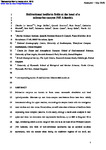Bidirectional bedform fields at the head of a submarine canyon (NE Atlantic)
| dc.contributor.author | Lo Iacono, C | |
| dc.contributor.author | Guillén, J | |
| dc.contributor.author | Guerrero, Q | |
| dc.contributor.author | Durán, R | |
| dc.contributor.author | Wardell, C | |
| dc.contributor.author | Hall, RA | |
| dc.contributor.author | Aslam, T | |
| dc.contributor.author | Carter, GDO | |
| dc.contributor.author | Gales, JA | |
| dc.contributor.author | Huvenne, VAI | |
| dc.date.accessioned | 2020-06-08T11:17:40Z | |
| dc.date.available | 2020-06-08T11:17:40Z | |
| dc.date.issued | 2020-07-15 | |
| dc.identifier.issn | 0012-821X | |
| dc.identifier.issn | 1385-013X | |
| dc.identifier.other | 116321 | |
| dc.identifier.uri | http://hdl.handle.net/10026.1/15740 | |
| dc.description | 12 months embargo applies. | |
| dc.description.abstract |
Submarine canyons are known to force ocean mesoscale circulation and local hydrodynamics. Alternate up- and down-canyon near-bottom flows have been widely documented along the upper reaches, connecting the canyon heads with the contiguous outer shelves and vice versa. Nonetheless, we still miss clear evidence of bedform fields expressing these complex patterns. In this study, through a multi-scale analysis in both space and time, we document rare asymmetric bedforms, up to 880 m long and 10 m high, developing within a depth range of 168-220 m at the head of the Whittard Canyon (NE Atlantic). One field of well-developed sandwaves has an atypical up-slope asymmetry, with the steeper slope facing the shallower regions of the shelf, and contrasting with surrounding down-slope sandwaves facing the canyon. The bedforms are interpreted to represent both up-slope and down-slope bottom currents connecting the upper reaches of the canyon to the outer shelf on the southern Celtic Margin, in the Bay of Biscay. The sandwaves were surveyed with shipboard Multibeam bathymetry (5 m grid cell resolution), AUV sidescan sonar (0.15 m grid cell resolution) and ROV footage, and sampled with three ROV-mounted vibro-cores and two box-cores. Sidescan sonar mosaics groundtruthed by sediment samples and ROV footage show with unprecedented detail spectacular trains of fresh overprinting megaripples, previously undocumented sand peaks and bowl-shaped depressions on the crests of the tallest sandwaves. Differences in sedimentary settings and benthic habitats indicate that these features are currently active in particularly dynamic areas, allowing for very slow migration of sandwaves. Numerical modelling together with concurrent hydrographic observations suggest large-amplitude semi-diurnal internal tides, possibly transitioning to asymmetric internal bores, as the main mechanism maintaining the mapped up-slope sandwaves. This work highlights the importance of uncommon sediment dynamics in canyon head environments and adds insight to the traditional notions of gravity-driven processes, being dominant in these environments, envisaging implications for improving geo-hazard assessment of mobile substrates and quantification of offshore sediment and carbon fluxes. | |
| dc.format.extent | 116321-116321 | |
| dc.language | en | |
| dc.language.iso | en | |
| dc.publisher | Elsevier BV | |
| dc.rights | Attribution-NonCommercial-NoDerivatives 4.0 International | |
| dc.rights | Attribution-NonCommercial-NoDerivatives 4.0 International | |
| dc.rights | Attribution-NonCommercial-NoDerivatives 4.0 International | |
| dc.rights | Attribution-NonCommercial-NoDerivatives 4.0 International | |
| dc.rights | Attribution-NonCommercial-NoDerivatives 4.0 International | |
| dc.rights.uri | http://creativecommons.org/licenses/by-nc-nd/4.0/ | |
| dc.rights.uri | http://creativecommons.org/licenses/by-nc-nd/4.0/ | |
| dc.rights.uri | http://creativecommons.org/licenses/by-nc-nd/4.0/ | |
| dc.rights.uri | http://creativecommons.org/licenses/by-nc-nd/4.0/ | |
| dc.rights.uri | http://creativecommons.org/licenses/by-nc-nd/4.0/ | |
| dc.subject | bedforms | |
| dc.subject | submarine canyons | |
| dc.subject | internal tides | |
| dc.subject | geomorphology | |
| dc.subject | seafloor mapping | |
| dc.subject | marine robotics | |
| dc.title | Bidirectional bedform fields at the head of a submarine canyon (NE Atlantic) | |
| dc.type | journal-article | |
| dc.type | Article | |
| plymouth.volume | 542 | |
| plymouth.publication-status | Published | |
| plymouth.journal | Earth and Planetary Science Letters | |
| dc.identifier.doi | 10.1016/j.epsl.2020.116321 | |
| plymouth.organisational-group | /Plymouth | |
| plymouth.organisational-group | /Plymouth/Faculty of Science and Engineering | |
| plymouth.organisational-group | /Plymouth/Faculty of Science and Engineering/School of Biological and Marine Sciences | |
| plymouth.organisational-group | /Plymouth/REF 2021 Researchers by UoA | |
| plymouth.organisational-group | /Plymouth/REF 2021 Researchers by UoA/UoA07 Earth Systems and Environmental Sciences | |
| plymouth.organisational-group | /Plymouth/Users by role | |
| plymouth.organisational-group | /Plymouth/Users by role/Academics | |
| dcterms.dateAccepted | 2020-05-01 | |
| dc.rights.embargodate | 2021-5-19 | |
| dc.identifier.eissn | 1385-013X | |
| dc.rights.embargoperiod | Not known | |
| rioxxterms.versionofrecord | 10.1016/j.epsl.2020.116321 | |
| rioxxterms.licenseref.uri | http://creativecommons.org/licenses/by-nc-nd/4.0/ | |
| rioxxterms.licenseref.startdate | 2020-07-15 | |
| rioxxterms.type | Journal Article/Review |



